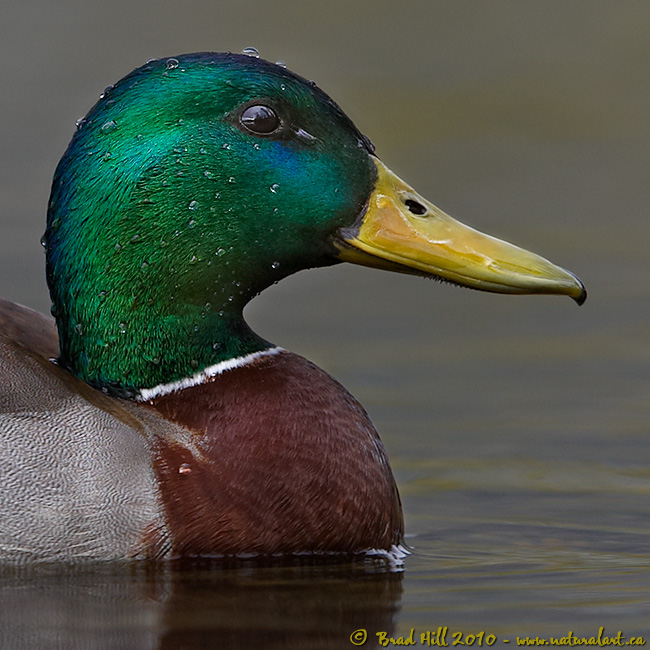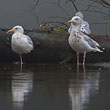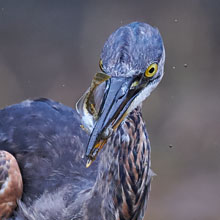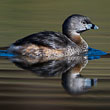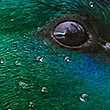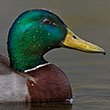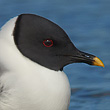Availability: Undetermined - Enquiries?
In the Field
Mallard Portrait - To Crop or Not to Crop? Haynes Point Provincial Park, Osoyoos, BC. April 21, 2009.
Shooting this portrait of the very common Mallard was fun and challenging. And, trying to decide on how to present the image online presented a further problem: part of the appeal of the image lies in the gorgeous details of the bird's plumage (and those sparkling water droplets). If I presented the entire image as shot (which includes the entire duck and some surrounding water), then much of the detail is greatly diminished or lost (such as the water droplets on the Mallard's head and the reflection of the lake in its eye). But...another key to the image is showing the entire bird and how the beautiful colours and textures of its plumage work so well together. My solution? Offer two versions of the image - there's much to discuss about it anyway (and, given that its my website, I can pretty much make up the rules as I go along...). This image is a significant crop of the original...
I shot this image under lightly overcast sky and with relatively diffuse lighting. This is pretty much my favourite lighting for showing the detail and nuances of bird plumage (and mammal pelages). The duck had been doing what ducks do - dabbling for aquatic invertebrates and other food sources just under the water - which gave me the those great water droplets to work with.
This image - and my struggle in deciding the best means to present it online - illustrates an important point about digital photography: the choices you make in how to display an image (things like tightness of the crop, animalscape vs. close-up, etc.) should vary with the content of that image and how/where it is going to be displayed (specifically - is it for online presentation or to be printed?). Images that look great as prints are often complete failures when presented online. And, conversely, some images that look great online don't come out great as prints. One of the rules of thumb I go by is that if extreme visual detail is critical to making an image work (which isn't always the case), then often the image works better as a print than it does online. This is especially true if the fine detail must be shown over the entire image and/or if your subject occupies only a small portion of the image. So...don't be surprised when that full-resolution animalscape (i.e., wildlife shot where the subject is captured within its natural habitat and is only a small subset of the entire image) that looks so great when printed (or when completely filling a 30" monitor) looks very ho-hum when reduced in resolution for web presentation or to email to someone! The bottom line? Most computer monitors simply don't have enough resolution to do justice to images who's success lies in seeing final detail throughout the entire frame, especially when the image is reduced to a size small enough for online presentation.
On the other hand, computer monitors can REALLY make colours pop - so if brilliant colour is critical to making an image "work", then often the image will be better received online than in print form (although it should be acknowledged that the lack of colour consistency between monitors can really have a pretty big negative impact as well - if this mallard's head looks pink on your monitor you probably won't like the image!).
I see at least two repercussions of this "how to best display an image?" conundrum. First, if you're building a website to showcase your images, you may have to select very different images (or crops of those images) than you would if you were putting together a printed portfolio. This can mean simply that you choose a slightly tighter crop if the image is going online. Second, when shooting your images, it can be important to be thinking about how the image is going to be used before you shoot. For example, if you're shooting for online display, you MIGHT consider moving in a little closer (with "tighter" in-camera framing) than you would if you were shooting images destined to become larger fine art prints. I often now find myself making sure I cover myself for all potential image uses and work a subject more thoroughly (including both close-ups and more distant views) than I used to. I fully expect that as more and more photographers move towards nearly exclusive electronic presentation of their work we'll start to see a shift in how images are captured in the field (similar to how the narrow audible dynamic range of portable media players like iPods is beginning to influence how artists create their music).
Just some food for thought...
Behind the Camera
Mallard Portrait - To Crop or Not to Crop? Haynes Point Provincial Park, Osoyoos, BC. April 21, 2009.
Digital Capture; Compressed RAW (NEF) 14-bit format; ISO 200.
Nikon D700 with Nikon 200-400 mm f/4G ED-IF AF-S VR lens @ 400 mm supported on Gitzo G1228 Mk2 Mountaineer carbon fibre tripod with Acratech Ultimate ballhead. VR turned to "On" and in "Normal" mode.
1/125s @ f5.6; -0.33 stop compensation from matrix-metered exposure setting.
At the Computer
Mallard Portrait - To Crop or Not to Crop? Haynes Point Provincial Park, Osoyoos, BC. April 21, 2009.
RAW Conversion to 16-bit TIFF, including first-pass/capture sharpening and shadow/highlight adjustments using Phase One's Capture One Pro 4.7. Five RAW conversions at different exposure settings - ranging from -1 stop (for surrounding water) through to +1.75 stops (for portions of the flank and head region).
Further digital corrections on 16-bit TIFF file using Adobe's Photoshop CS4. Adjustments included compositing and masking of 5 exposure versions, selective colour saturation and desaturation, selective exposure curve adjustment, and selective sharpening for web output.
Conservation
Mallard Portrait - To Crop or Not to Crop? Haynes Point Provincial Park, Osoyoos, BC. April 21, 2009.
Ten percent of the revenue generated by this image will be donated to Wildsight.
Species Status in Canada*: This species is not designated as at risk.
The Mallard (Anas platyrhynchos) is the most abundant duck species in North America. In many respects it is the standard against which all other duck species are compared and is what many people think of when the work "duck" is mentioned.
The widespread distribution and huge numbers of Mallards in North America is a testament to its adaptability to diverse habitats, its ability to withstand cold climates, its acceptance of a wide variety of food types, and its tolerance of humans. In 2000 it was estimated that there were over 10 million Mallards in the mid-continent regions of North America. Each year roughly 20-25% of the autumn population of Mallards is harvested by hunters, which represents roughly 40% of the total kill of all waterfowl.
While Mallards are not considered at threat, many ecosystems within the Columbia Valley face development pressure, including wetlands critical to the local survival of Mallards. Wildsight is an effective conservation organization that protects biodiversity and promotes sustainable communities in Canada's Columbia and Rocky Mountains. Support for Wildsight, through donation or becoming a member, will help ensure that they remain effective in their efforts to conserve threatened or endangered species and ecosystems.
*as determined by COSEWIC: The Committee on the Status of Endangered Wildlife in Canada













